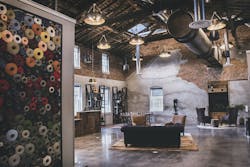The hotel complex is uniquely Amana from the customer’s first step into the lobby. The design team incorporated old equipment from the mill. On the left, the yarn wall is a nod to the woolen production that still occurs on site.
Adaptive reuse is one of the greenest building strategies available. Presenting an alternative to demolition and new construction, adaptive reuse—the practice of taking an old building or site, preserving what’s best about it and using it for a purpose other than what it was originally designed for—repurposes structures that might otherwise be demolished and creates something new and exciting from them.
After downsizing and changes in the textile industry, many of the buildings in the Amana mill complex were empty or underused. An adaptive reuse project transformed them into a luxury boutique hotel with ample gathering space.
Hotel Millwright, a new luxury boutique hotel in Amana, Iowa, is a shining example of this practice. Originally founded as a thriving woolen mill in 1855, what is now Hotel Millwright was once the industrial center of the village of Amana. The textiles produced there were sold across the country and gained a national reputation for quality and craftsmanship, something the Amana Colonies (a group of seven villages in the Amana area) are still known for today.
“The Amana Colonies are a National Historic Landmark, one of Iowa’s top visitor attractions and a top historic attraction,” explains Jeff Popenhagen, chief revenue officer of the Amana Society. “Preserving the physical structures that are an essential part of Amana’s story and using those structures in ways that celebrate that story is vital to maintaining this Iowa treasure.”
The road from former mill to boutique hotel was long, but worth it, producing a true gem in the Eastern Iowa hospitality scene. Here’s how it happened.
Creating a Hotel from Historic Structures
The hotel complex is part of an 8-acre setting next to the Mill Race Canal. It originally hosted 13 buildings, but over time, downsizing and changes in the industry left many of the buildings empty or underutilized.
The Amana Society, a legacy corporation that safeguards the area’s heritage and works to distribute Amana Colonies products nationwide, needed to preserve the story of the site, and that included saving the historic structures found in the mill complex.
The Amana Society brought in third-party firms to find the best uses of the site to ensure its economic stability and found that the best plan was “a multi-use approach that enhances Amana’s position as a hospitality and entertainment destination,” Popenhagen explains.
The mill complex originally included 13 buildings. It’s now the home of a luxury boutique hotel with 65 guest rooms, two comfortable gathering spaces and 7,000 square feet of event space.
The adaptive reuse project converting the mill complex into a luxury boutique hotel destination wasn’t easy, notes Matt Hansen, project manager with Compass Commercial Services. The locations of windows, beams and columns presented difficulties in the initial layout. Compass incorporated columns and beams into new walls and creatively framed around windows.
Further complicating the process, the mill complex had been rebuilt over a 40-year span after a 1923 fire, which “resulted in more than eight additions causing obstacles with the interior floor elevations and, in some cases, limited ceiling heights,” Hansen says. “Blessed with long and wide corridors, we could reduce floor elevations with new elevators and ramps.”
Bringing the complex up to current code was also a challenge. The complex needed new code-compliant staircases, elevators, doors and hardware, as well as new mechanical, electrical, plumbing and sprinkler systems on all new walls and other areas where they were needed in the existing structure, Hanson explains.
Their hard work paid off. The Midwestern oasis is now open for business, featuring a full-service, two-story hotel with 65 guest rooms, creatively designed gathering spaces and extensive event space. And, true to its heritage, textile workers are still hard at work today in the complex’s historic weaving building, which now includes a 7,000-square-foot event space called Merino Loft. Weavers create blankets and bags available at shops in Amana, as well as bed scarves and other accent pieces for Hotel Millwright.
Relaxing guest rooms incorporate Amana woolens produced on site.
Hotel Millwright Now
The hotel site is a celebration of all things Amana. Walk through the hotel complex to find wheels, pulleys, gears, levers and drive shafts left hanging in their original homes.
“The equipment dates back to when the Mill Race canal powered the mill, where it was restored and situated throughout the hotel,” Popenhagen says. “The blending of old with new showcases the mill structures’ beauty and character and highlights the hotel’s special on-site services.”
Heavy machines and tools mix with soft woolens, warm woods and exposed brick to create a look that’s uniquely Amana. In each space, photos of millwrights and mill workers tell the story of what happened in the space, linking the past with the present.
Guests can see how the lobby was transformed from a former boiler room or how the Electric Thread Social Club, a whiskey bar serving craft spirits and small bites, stands where the mill once met the water.
“We wanted to keep things simple and let the mill’s historic elements, photography, art and artifacts do the talking,” explains Sara Montgomery, creative director of the Amana Society.
The interior design also draws on local inspiration. The Amana Colonies are known for fine handcrafted goods, and the hotel complex reflects that—not just with the textiles made on-site, but with pieces created by the Amana Furniture Shop arranged artfully throughout the corridors. Even the flight boards in the Electric Thread Social Club were created by talented Amana woodworkers.
These disparate elements come together to create a site that both honors its roots and looks toward the future. As Popenhagen says, “Hotel Millwright is now a place for memories, a place for stories and a place to share the community.”
About the Author
Janelle Penny
Editor-in-Chief at BUILDINGS
Janelle Penny has been with BUILDINGS since 2010. She is a two-time FOLIO: Eddie award winner who aims to deliver practical, actionable content for building owners and facilities professionals.

